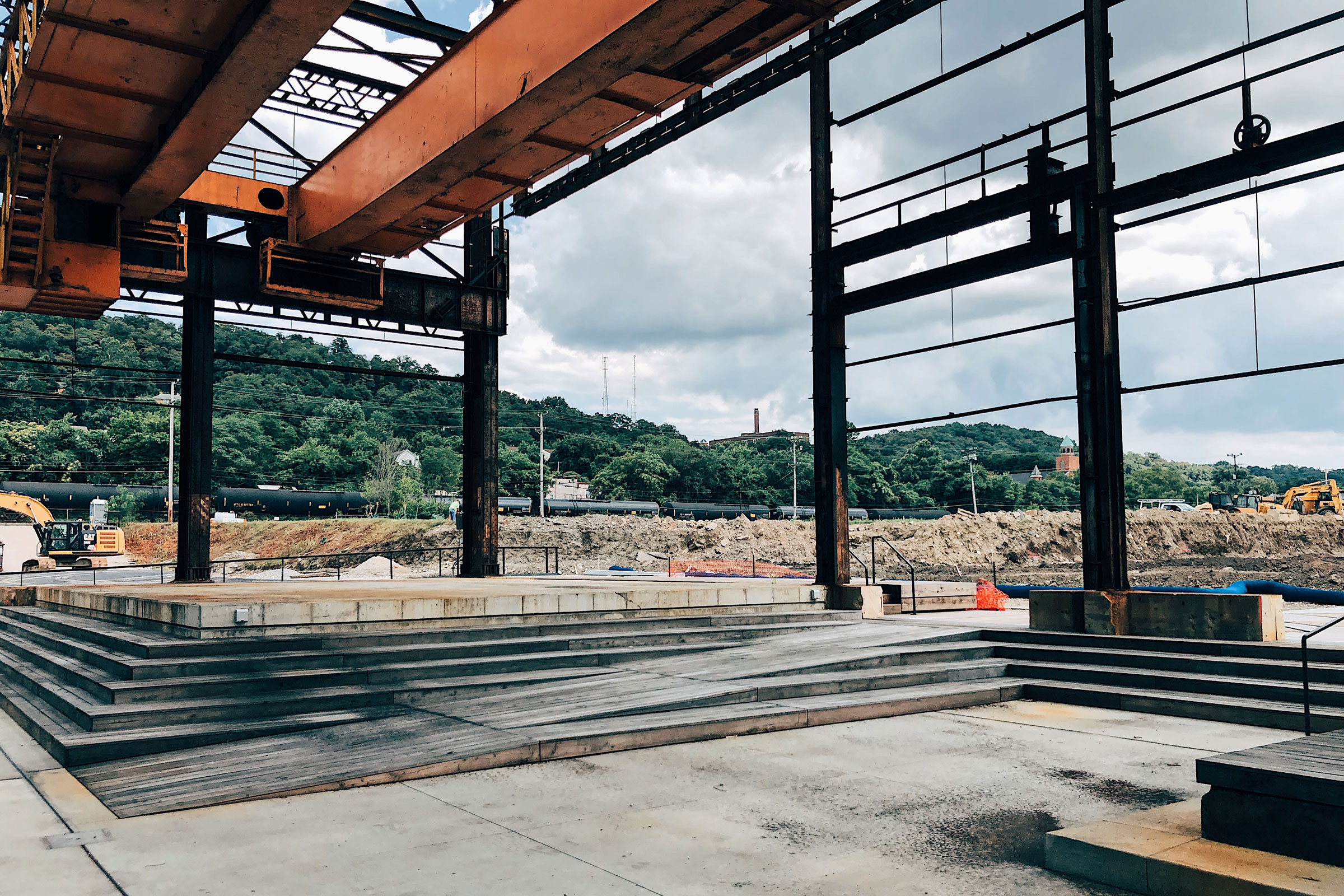Story at a glance:
- With a growing population flocking to urban environments, the use of brownfields will aid in maintaining sustainable city sizes.
- Several cities around the globe have successfully adapted brownfield sites into innovative community spaces and modern, affordable housing.
- Utilizing brownfields helps to save on construction time and reinvigorate communities.
As economies around the globe become more focused on technology, urbanization and cities continue to grow. According to the UN, 68% of the world’s population will live in urban environments by 2050. That’s an estimated seven billion people, around two-thirds of the world’s population. Aside from the heavy amounts of pollution that urbanization causes, another major issue is space. Finding ways to adapt to the ever-growing population while trying to contain the urban sprawl is going to be a major obstacle, and while there are some innovative solutions in the works, many major cities have already started finding new ways to use what they already have, through adaptive reuse projects and reclaiming brownfields.
The EPA defines a brownfield as a property—the expansion, redevelopment, or reuse of which may be complicated by the presence or potential presence of a hazardous substance, pollutant, or contaminant. Basically it’s a piece of land that was being developed for industrial purposes but has since been abandoned. Common examples of brownfields include former gas stations, landfills, dry cleaners, and metal plating facilities.
Cleaning up and using a brownfield site for development can come with many advantages, like saving on time and money for construction due to already existing infrastructure, lowering the need to expand an urban environment, and helping to facilitate job growth within the surrounding community. Here are seven projects from around the globe that successfully adapted the use of brownfield sites.
1. Springdale Green, Austin, TX
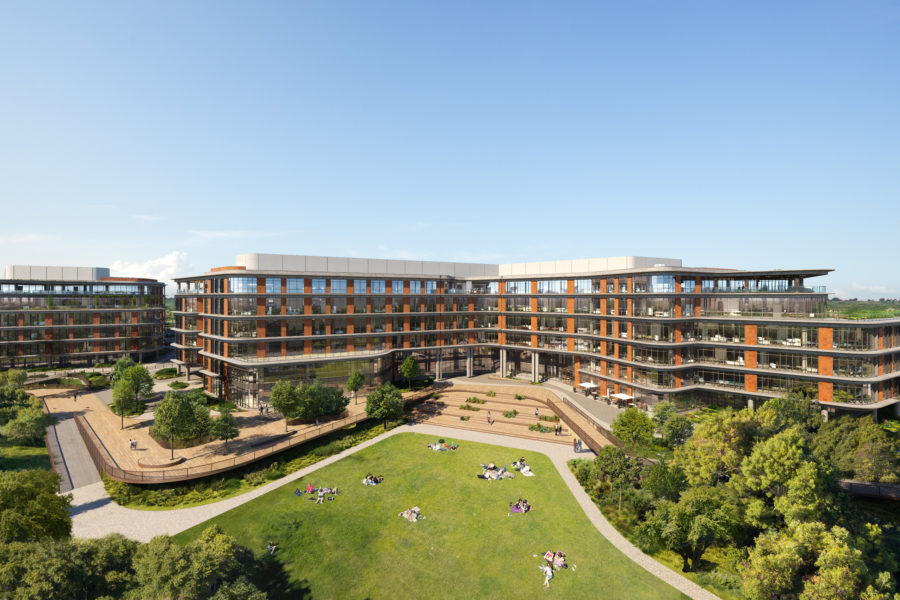
Nestled amongst a restored preserve, the project will transform a former brownfield into a verdant oasis, returning 30 acres of green space to the community. Rendering courtesy of Gensler and dwg
Built from the ground up upon a former brownfield, Springdale Green is set to be a scenic office campus immersed in a bed of nature. The 30-acre campus will contain office buildings nestled among a restored ecological landscape complete with native meadows, a woodland, and an urban creek. Patios and lounging areas will be scattered throughout the space, providing people with a place to relax or host a work meeting.
“Springdale Green represents a paradigm shift—healing and restoring a neglected site into a native ecological landscape that is innovative and natural,” said Daniel Woodroffe, president and founder of dwg, in a press release. “All of these efforts create a highly performative and functional environment that achieves the highest standards of sustainable design.”
A 600,000-gallon underground cistern will be used to capture both rainwater as well as air conditioning condensation, and a combination of rain gardens and a bioretention basin will be utilized to treat the stormwater and irrigate the landscape. Aside from office buildings, the massive campus is set to also house an amphitheater, an outdoor kitchen, a yoga deck, volleyball and basketball courts, and a wellness center. The project is targeting LEED Gold and Austin Energy Green Building 3-Star. When completed in late 2023, Springdale Green will set the bar for sustainability.
2. The Stratford, London, UK
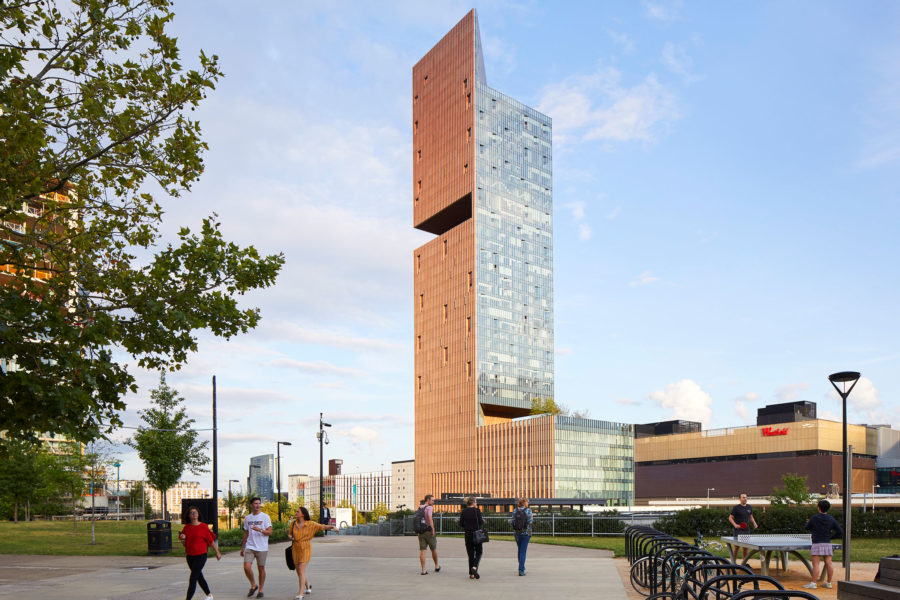
The Stratford is a sustainable 42-story residential and hotel high-rise in East London. Photo by Hufton + Crow Photography
The Stratford is a 42-story residential and hotel high-rise that was built upon a brownfield site in East London. Erected in a part of town that’s more accustomed to horizontal row houses and flats, the tower overlooking Queen Elizabeth Olympic Park still manages to incorporate the idea of a neighborhood by offering amenities like gyms, restaurants, cultural art centers, and retail shops. Three sky gardens aid in facilitating outdoor activities, giving the community an area to interact and socialize, much like a small park.
“I took inspiration from residential areas of London, with the purpose of unifying and strengthening the local community,” said Mina Hasman, an associate director at SOM, in a previous article for gb&d. “As our cities are rapidly growing we need to consider the intelligent densification of our cities, which will require more high-rises to be inserted into areas with limited land available.”
Along with the use of a brownfield, the high-rise is built with sustainability in mind as it was oriented and shaped to allow for natural winds to aid in passive cooling of the building. A district-wide heating network uses hot and cold water for additional heating and cooling of the community, and the sky gardens utilize local plants and selected species that aim at boosting the natural ecosystem.
3. DADA Distrikt, Brno, CZ
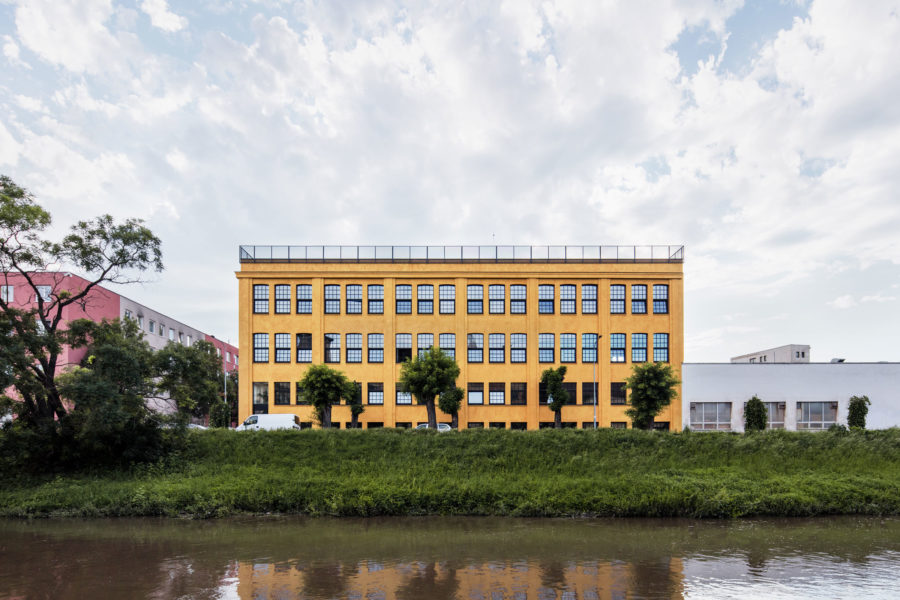
DADA Distrikt, designed by KOGAA Architects. Photo by Kubicek Studio
A former storage facility in the city of Brno in the Czech Republic was listed as a brownfield, but a team of architects at KOGAA was able to repurpose it into an affordable housing option. Now known as DADA Distrikt, the 3,000-square-meter building sits across from the Svitava river in Brno’s Husovice district and offers 13 units for housing and four office spaces.
“The local market lacks affordable housing and therefore calls for alternative development solutions that would also be able to strengthen the quality of public spaces,” said KOGAA cofounder Alexandra Georgescu about DADA Distrikt in a previous article for gb&d. “Its relatively economical reconstruction was made possible through shared funding and direct sales, therefore avoiding additional investment returns to developers and fees to real estate agencies.”
The team at KOGAA was able to make ample use of the existing infrastructure by maintaining the building’s original staircase, and repainting the facade, giving it a decorative accent. A green roof was also installed in order to aid in water management while greywater is used for irrigation.
4. Mill 19 & Hazelwood Green, Pittsburgh, PA
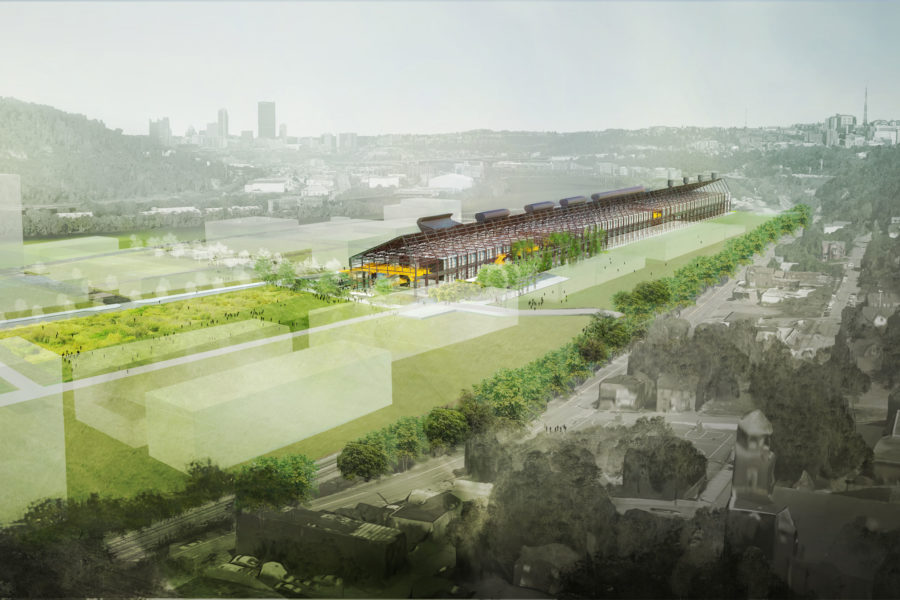
The 1.3-mile stretch of land along the Monongahela River is being revitalized to include trails and public spaces filled with industrial artifacts that reflect the site’s history. Rendering courtesy of Ten X Ten
Hazelwood Green is a 178-acre brownfield site located in southeast Pittsburgh, and it’s being developed into a center of innovation that promises to fuel Pittsburgh’s economy while remaining sustainable. The property holds historic value as the site of the Jones & Laughlin steel mills, sparking Pittsburgh’s iconic steel industry, and while most of the buildings have been cleared away, the three rolling steel mills were preserved to make up what is now known as Mill 19.
The 1.3-mile stretch of land along the Monongahela River is being revitalized to include trails and public spaces filled with industrial artifacts that reflect the site’s history. There is also space being made for office, retail, and residential buildings, and Uber has even found an area to put up a test track for their autonomous vehicles.
The steel superstructure of Mill 19 has been stripped down to its bones and its insides have been replaced with manufacturing and research plants focused on robotics, A.I., and automation. A PV array of 5,000 solar panels now powers the facility, making it the largest in Pittsburgh history—and the largest sloped-roof installation in the country. The site is designed with long-term sustainability in mind and has achieved the LEED Gold certification.
5. Austin Central Library, Austin, TX
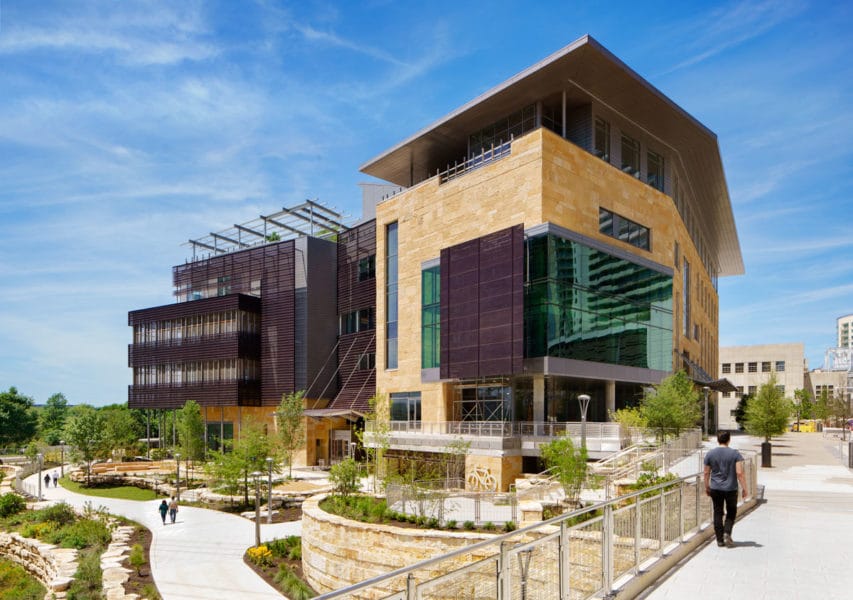
The Austin Central Library. Photo courtesy of Lake|Flato
Sitting upon the former brownfield site of the old Seaholm Power Plant, the Austin Central Library was built in the vein of both sustainability and productivity. Designed to maximize the use of daylight, a six-story atrium sits at its core providing more than 80% of light to its occupied spaces. Sitting adjacent to Shoal Creek and Lady Bird Lake, visitors can enjoy the lush views from the library’s rooftop butterfly garden.
“You can hang out over the lake as a citizen overlooking nature,” said David Lake, principal in charge for Lake|Flato, in a previous gb&d article. “The presence of daylight makes people feel happy and more productive. It makes people want to be there.”
The library uses three solar arrays—567 solar panels with a total of 180 kilowatts—for power, and a 373,000-gallon cistern—part of the decommissioned plant—is used to collect rainwater and HVAC condensation for its restrooms and irrigation. Local and recycled materials were used during development and 100% of the plants that make up the landscape are native. Pedestrian walkways and bike trails have been constructed around the library, making it a bustling area of the city as well as Austin’s first EcoDistrict.
6. NorthEdge, Seattle, WA
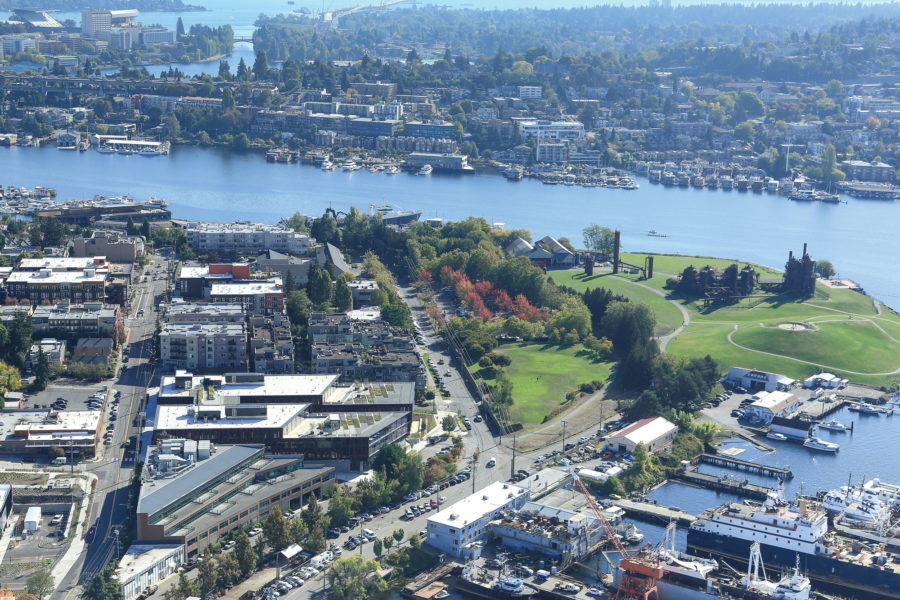
Encompassing an entire city block, the four-story building was designed with the community in mind. Photo courtesy of Tim Rice
A stretch of derelict public works and industrial low-rise buildings once sat in Seattle’s neighborhoods of Fremont and Wallingford, blocking the scenic views of Lake Union. In 2016 the expansive brownfield had undergone a transformation and was replaced with a 208,000-square-foot office building dubbed NorthEdge. Encompassing an entire city block, the four-story building was designed with the community in mind, with its vast glass walls and central terrace that provide views to the captivating waterfront below.
“The idea of reclaiming land used for an industrial purpose was, conceptually, something we wanted to build on,” said Erik Mott, design principal at Perkins + Will, in a previous article with gb&d. “There was an opportunity to create a public space, a place for a community to have an identity and to experience the water’s edge.”
Bike and kayak storage is offered to adapt the communities alternative methods of travel, and a natural watershed helps to reduce water usage. The building currently holds an LEED Silver sustainability rating.
7. Dalston Works, London, UK
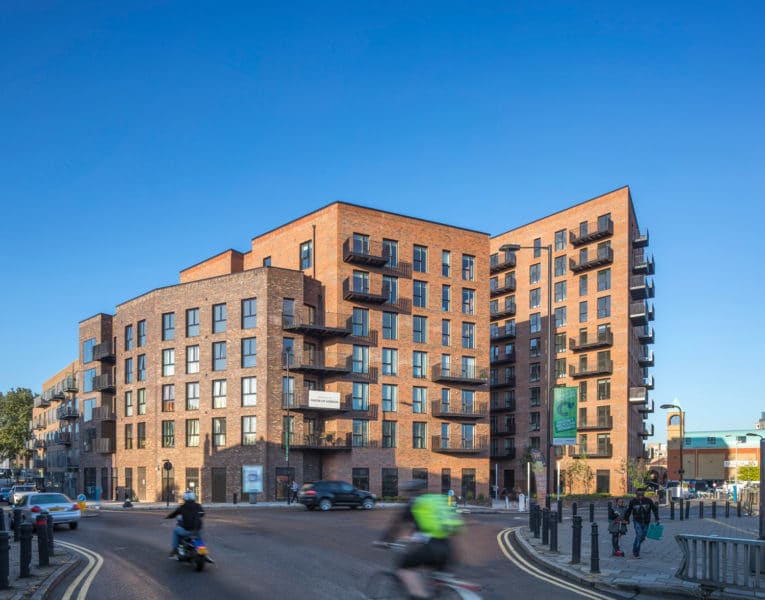
Dalston Works is one of the world’s largest CLT buildings. Photo by Daniel Shearing
Dalston Works—the world’s largest building constructed out of cross-laminated timber (CLT)—is a 10-story, 121-unit residential property that was built upon a neglected brownfield site. The building was constructed in the continual pursuit of keeping London’s urban sprawl to a minimum by providing high quality, high-density housing that also yields a healthy, natural living environment. By using CLT instead of concrete, the weight of the building was vastly reduced, allowing an efficient use of the brownfield.
“The reduced weight of CLT allowed architects to make the building larger—and complete it faster,” said Damien Cartmell, managing director of construction at Regal London and developer of Dalston Works in a previous gb&d article. During construction the CLT components were prefabricated and shipped to the site. This helped to maintain low onsite waste, and onsite deliveries were reduced by 80%.
CLT is a renewable resource that’s both faster and cheaper than traditional building materials, and the wood acts as a carbon reservoir—making sure to store carbon for the life of the material. The building contains a natural ventilation system to help maintain the temperature and the roof heights are staggered in an alternating wave-like pattern in order to maximize daylight for apartments and open, communal spaces.

